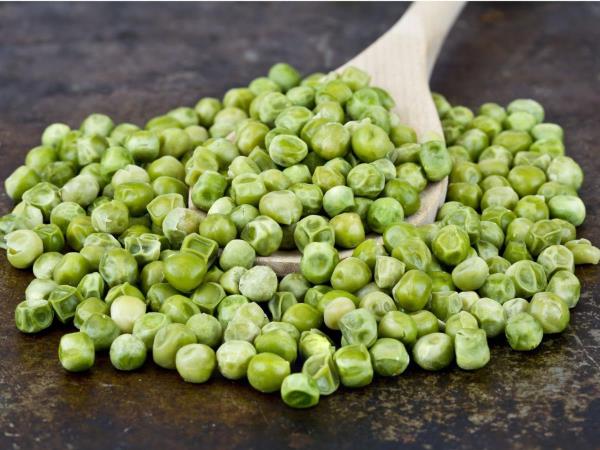What is resistant starch?
Resistant starch is a type of carbohydrate that behaves more like fiber in the body rather than sugar. When consumed, it does not enter the bloodstream like regular starch (for example, from white bread or pasta), but travels to our digestive system, where beneficial bacteria in the colon grab it and use it as food. This process is called fermentation - a natural breakdown of food with the help of bacteria.
And why is this important? Because during this fermentation, substances are produced that help regulate blood sugar levels, promote insulin production, and improve the function of the intestinal microbiota, the entire community of bacteria in our digestive system, which affects almost everything: from mood to the immune system and metabolism.
What do the studies say?
One of the latest studies, published in the scientific journal Nature Food, showed that meals containing wrinkled peas can contribute to a more stable blood sugar level. In the study, volunteers consumed 50 grams of wrinkled peas in various forms - as part of a mixed meal, hummus, or porridge. Interestingly, the same volunteers also tried regular, smooth peas - the kind typically found in stores or cans.
Results?
Meals with wrinkled peas caused a smaller increase in blood glucose after consumption. This means that the body did not experience such a sugar spike, which is often the starting point for the development of diabetes.
To better understand why this is important: every time we consume something with a high glycemic index (e.g. white bread, rice, potatoes), our blood sugar quickly rises. This forces the body to release more insulin - the hormone that helps sugar enter cells. If this happens frequently, insulin resistance can develop, which is the first step towards type 2 diabetes. According to the World Health Organization, by 2045, this disease is expected to affect over 700 million people.
What does the intestinal microbiota say about this?
In the study, researchers used microscopic tracer molecules to track how peas are digested in the body. They discovered that resistant starch from wrinkled peas also influences the composition of the intestinal microbiota. This change has long-term effects: it's not just about lower blood sugar after one meal, but about overall metabolic improvements. In some volunteers, after four weeks of regular consumption of pea hummus and porridge, changes in the bacterial balance of the intestines were observed, which could mean long-term benefits for the heart, weight, and even mood.
Preparation is also important
Interestingly, researchers went a step further. They tried to mimic the functioning of the human colon in a laboratory and found that the way peas are prepared plays a significant role. Peas that were prepared in a certain way (cooked and then mashed or fermented into hummus) were digested more slowly by the body. This is crucial because slower sugar release means a more stable blood glucose level and less burden on metabolism.
In the experiment, they compared how the body digested peas that were cooked and cooled, versus those that were freshly cooked and hot. Surprisingly, the cooled peas caused up to 35% less blood sugar spike compared to the hot ones. This is due to a phenomenon called starch retrogradation, where part of the starch becomes more resistant during cooling. In other words: sometimes, a cold dinner is better than freshly cooked!
What does this mean for you?
If you have a family history of diabetes, are overweight, sedentary, or over 45 years old, you have a higher risk of developing type 2 diabetes. According to the National Institute of Public Health, in Europe, nearly 15% of the population already has diabetes or is in a so-called pre-diabetic phase, where sugar levels are slightly elevated but the disease is not fully developed. This is not a small number.
Therefore, it makes sense to include more foods with a low glycemic index, rich in fiber and resistant starch in your diet. Peas with wrinkled seeds are an excellent ally in this. Especially if you prepare it as hummus, soup, or a chilled salad.
Fun fact
Wrinkled peas are not a new genetically modified variety, but a natural variation first noticed by the well-known monk Gregor Mendel in the 19th century, the father of genetics. He was the one who first described the inheritance of traits by observing pea crosses.
And now, almost 200 years later, science is once again showing how incredible a gift of nature this plant is.
How to incorporate it into your diet?
Very simply. Use it as a base for:
- hummus (with added olive oil, garlic, and lemon),
- pea soup (can be made with added ginger and turmeric, which further stabilize blood sugar),
- vegetable salads with chilled peas,
- pea patties with chickpeas.
Due to its rich protein content (about 5 g per 100 g of cooked peas), fiber (up to 6 g), and resistance to digestion, it will keep you satisfied for longer without causing significant blood sugar fluctuations.
Conclusion
The story of peas is a story of how a simple, accessible, and traditional food can become a modern ally in the fight against one of the most common diseases of modern times. Research shows that just 50 grams of wrinkled peas a day, prepared in the right way, can significantly reduce the glycemic response after a meal.
So, if you want to do something good for yourself, especially if you have issues with energy, well-being, or are concerned about what the future holds, take a moment and look at your plate. Perhaps the humble pea will surprise you more than you'd think.









 Would you like to be informed about news on the website?
Would you like to be informed about news on the website?

